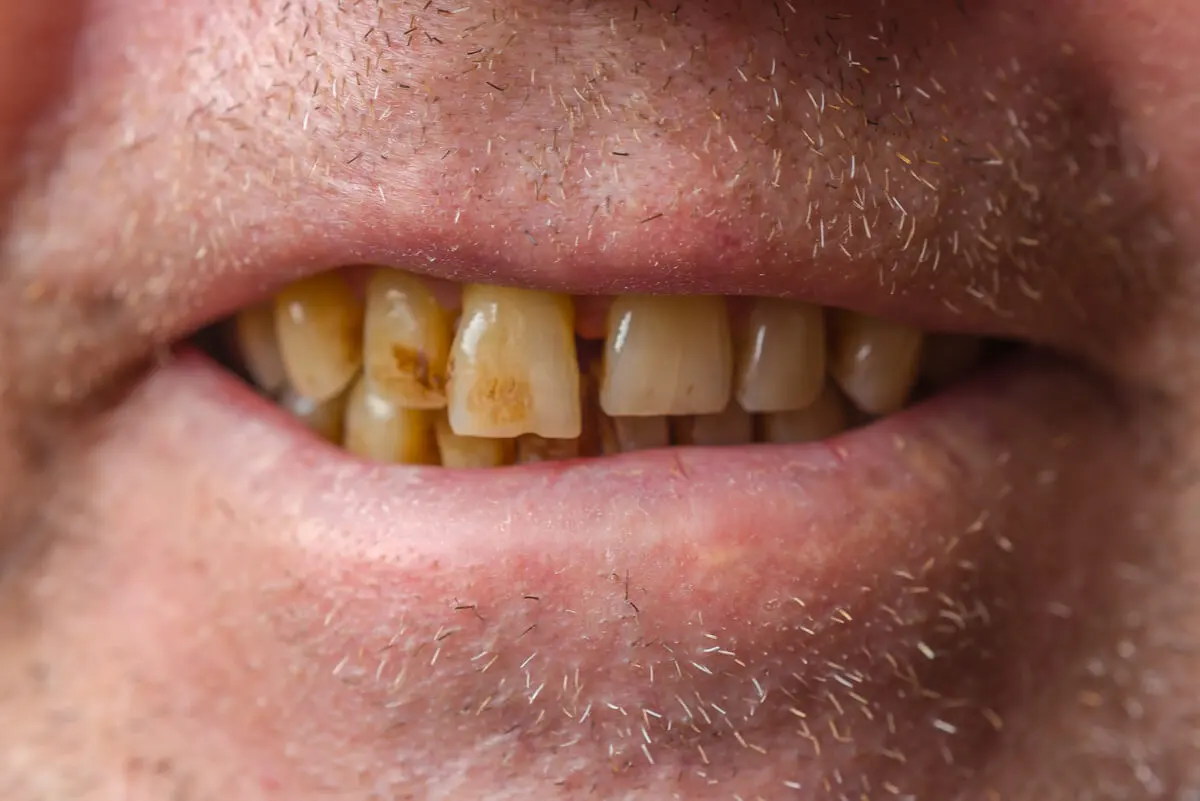Electronic Cigarettes: Do They Affect The Health of Your Mouth?


Written and verified by the dentist Vanesa Evangelina Buffa
Many people who vape are comfortable with the way they smoke and even believe it’s healthier. In this article, we’ll tell you how electronic cigarettes affect oral health.
Vaping is often seen as a less harmful alternative to smoking. But the use of nicotine and other toxic substances and their effects on oral structures are not taken into account.
What are electronic cigarettes and how do they work?
Electronic cigarettes are devices capable of heating a liquid and generating an aerosol. They consist of a space to contain the fluid, an element that generates the heat, and a battery that allows them to function.
This is the vapor generated that the person smokes, inhaling, and exhaling this mixture of tiny particles. The use of this type of product is called “vaping”.
There’s a wide variety of shapes and sizes on the market. There are cigarette-looking cigarettes, pipes, pens, USB sticks, and other everyday items.
The liquid used in electronic cigarettes usually contains nicotine, glycerin, propylene glycol, flavorings, and other chemicals and metals that promote the production of the aerosol. This is called “e-cigarette juice” and comes in the form of different flavored cartridges that are refilled.
Unlike conventional cigarettes, there’s no inhalation of tar or carbon monoxide. For this reason, many users consider e-cigarettes to be more harmless.
But the aerosols generated don’t only contain water vapor. When heated, the nicotine, glycerin, and other chemicals contained in the product are inhaled by the person.
These substances are harmful to health, carcinogenic and addictive. For this reason, there are more and more studies and health organizations that advise against their use.
We think you may also enjoy reading this article: Is Vaping a Better Alternative than Quitting Smoking for Good?
The effects of electronic cigarettes on oral and dental health
There’s a significant increase in the use of electronic cigarettes in the population, especially in young people and adolescents. Advertising messages describing it as a healthier alternative to traditional tobacco increase the public’s interest in experimenting with vaping.
The truth is that smoking in this way also has detrimental effects on a person’s health. Respiratory, nervous, digestive, circulatory, reproductive, and immune system conditions are associated with the use of electronic cigarettes. And the risks are not only for the consumer, but also for the people around them.
On the other hand, although this is one of the arguments for its use, it hasn’t been proven that it’s an effective measure to quit smoking. On the contrary, there are studies that postulate that having tried vaping increases the risk of nicotine addiction and, in non-smokers, encourages them to incorporate the habit later.
But how does the electronic cigarette act on oral health? Here are some of the negative effects of this habit in the mouth.

Problems in the oral mucosa
Nicotine reduces blood flow throughout the body, affecting the irrigation of the mucous membranes of the mouth. Thus, one of the consequences of e-cigarette use on oral health is a gingival recession.
The lack of vitality of the gingival tissue due to the decrease in nutrients and oxygen causes the gums to recede apically. This exposes the root of the tooth, causing sensitivity and favoring the installation of neck caries. And in untreated cases, the progression of the destruction of the supporting tissues and the loss of teeth.
Inflammation of the gums is another mucosal condition associated with the use of vaporizers. This is because the chemicals that reach the mouth are capable of irritating the mouth and throat. These tissues can become swollen, red, and sore.
On the other hand, the lack of nutrition in the mucous membranes prevents them from responding adequately in cases of injury. The healing and damage repair process is altered, making tissue recovery difficult.
This poor healing makes some dental treatments more difficult, increasing the risk of complications. The use of implants to rehabilitate mouths with missing teeth, for example, isn’t a good idea for this type of patient. This is a relevant fact to keep in mind, given the high prevalence of tooth loss in people who smoke.
Increased risk of infections
One of the ways in which electronic cigarettes affect oral health is by increasing the chances of developing the most prevalent infectious diseases of the mouth – that is, cavities and periodontitis. Both conditions, without timely treatment, can lead to the destruction or loss of dental elements.
Vaping decreases salivary production and favors the formation and accumulation of bacterial plaque. In addition, the sweet content of flavored aerosols favors bacterial metabolism and acid production, as if consuming candy or drinking a soft drink. If poor dental hygiene is added to this, the chances of developing cavities increase.
This condition destroys the hard tissues of the dental pieces and advances toward the internal area of the teeth. If not treated in time, it can lead to painful conditions with pulp inflammation or infections. And if the damage to the tooth is very extensive or the complications very severe, it may even lead to the need to extract the piece from the mouth.
Due to gingival recession associated with patients who smoke, neck cavities are the most frequent. The destruction occurs in the root zone of the tooth, so it’s more aggressive and causes a great deal of sensitivity.
The onset of periodontal disease arises as a result of the progression of inflammation and untreated gingival recession. Deep tissue destruction and alveolar bone loss can lead to tooth mobility and even tooth loss. This condition is associated with other systemic diseases that affect overall health.
The use of electronic cigarettes can also favor the overgrowth of fungi specific to the mouth. The appearance of oral candidiasis, with white patches on the tongue or reddening of the mucous membranes, is a possibility in these people.
Like this article? You may also like to read: Five Positive Changes You’ll Notice after You Quit Smoking
Dry mouth
Despite the fact that when using an electronic cigarette the vapor of a liquid is inhaled, dry mouth is another oral health problem associated with its use. The presence of propylene glycol among the product’s components could favor xerostomia.
Dry mouth, in addition to being annoying, favors the development of cavities, the formation of bacterial plaque, and the appearance of sores. It also causes halitosis or bad breath.
Oral cancer
The mixture of toxic substances that enter the body when using electronic cigarettes could increase the risk of suffering any oral cancer. There’s still no concise evidence regarding the relationship between vaping and cancer, but most studies conclude that its use is harmful and similar to tobacco in the development of malignancy in cells.
Do electric cigarettes stain your teeth?
Traditional tobacco smoking colors teeth a yellowish or brownish hue that highlights the habit. In the case of electronic cigarettes, staining of the teeth is less likely.
This is due to the absence of tar in combustion, the leading cause of staining. This lower risk of staining teeth is an aspect used by advertising and e-cigarette marketers. However, there’s no evidence that shows the presence of dental staining due to their use.
In any case, the yellowing of teeth is an aesthetic problem and not a health problem. The lack of staining of the teeth when using these products is not a sufficient argument to validate their use. The damages of electronic cigarettes to oral health are much more serious problems.

No cigarettes are better than e-cigarettes
As we told you, using electronic cigarettes has many negative effects on oral health. And although this habit has gained popularity as a healthy product, it certainly isn’t healthy for the mouth.
Quitting smoking altogether is always the best decision for the person. There are countless health benefits when a person quits smoking.
In addition, it’s important to note that opting for electronic cigarettes as a method to eliminate the habit isn’t a good idea. In addition to its unproven efficacy, the health consequences are still harmful. And that’s not to mention that nicotine dependence could continue.
There are other less harmful and more scientifically supported alternatives to quitting smoking. In this case, seeking professional help is a good idea. And in the case that the habit of vaping is already installed, the best thing for oral health is also to try to quit the electronic cigarette. However, like any addiction, the process can be difficult and lengthy.
Taking care of your teeth with proper dental hygiene is essential to counteract the harmful effects of vaping in the mouth. A healthy diet, frequent hydration, and regular visits to the dentist are also part of oral care.
Finally, looking for alternatives to help quit smoking, in any of its versions, is the best way to take care of the mouth and have a healthy smile.
All cited sources were thoroughly reviewed by our team to ensure their quality, reliability, currency, and validity. The bibliography of this article was considered reliable and of academic or scientific accuracy.
- Jensen, R. P., Strongin, R. M., & Peyton, D. H. (2017). Solvent chemistry in the electronic cigarette reaction vessel. Scientific reports, 7(1), 1-11.
- Soneji, S., Barrington-Trimis, J. L., Wills, T. A., Leventhal, A. M., Unger, J. B., Gibson, L. A., … & Sargent, J. D. (2017). Association between initial use of e-cigarettes and subsequent cigarette smoking among adolescents and young adults: a systematic review and meta-analysis. JAMA pediatrics, 171(8), 788-797.
- Garza, E. E. P., Parra, R. O., Lara, C. A. L., Domínguez, J. H. L., & Saldierna, C. D. R. C. (2018). Cantidad de dientes perdidos en sujetos fumadores, no fumadores y exfumadores. Revista de la Asociación Dental Mexicana, 75(3), 143-146.
- Sánchez-López, A. P., Delgado-Rubio, R., & Barranco-Obis, P. (2021). Relación entre la utilización de cigarrillo electrónico y la aparición de cáncer. Nuberos Científica, 18-22.
- Parodi, C., Llambí, L., Barros, M., & Pippo, A. (2014). Cigarrillo Electrónico, un tema en controversia. Actas Odontológicas (Publicación discontinuada), 11(1), 39-44.
- Armendáriz-Castillo, I., Guerrero, S., Vera-Guapi, A., Cevallos-Vilatuña, T., García-Cárdenas, J. M., Guevara-Ramírez, P., … & Paz, C. (2020). Análisis del potencial genotóxico y carcinógeno asociado a los cigarrillos electrónicos. Revista Ecuatoriana de Medicina y Ciencias Biológicas, 41(1).
- Sánchez, J. J. T., & Navarro, P. C. SISTEMAS ELECTRÓNICOS DE ADMINISTRACIÓN DE NICOTINA.
- Accinelli, R. A., Lam, J., & Tafur, K. B. (2020). El cigarrillo electrónico: un problema de salud pública emergente. Revista Peruana de Medicina Experimental y Salud Publica, 37, 122-128.
- Laerte, D. S. D., Carmen Maria, R. U., & Lucia, G. N. (2018, October). CIGARRILLO ELECTRÓNICO.¿ UN PRODUCTO SEGURO?. In morfovirtual2018.
- Usuga David, M. (2021). Efectos nocivos del cigarrillo electronico para la salud humana.
- Camenga, D., Gutierrez, K. M., Kong, G., Cavallo, D., Simon, P., & Krishnan-Sarin, S. (2018). E-cigarette advertising exposure in e-cigarette naïve adolescents and subsequent e-cigarette use: a longitudinal cohort study. Addictive behaviors, 81, 78-83.
This text is provided for informational purposes only and does not replace consultation with a professional. If in doubt, consult your specialist.








